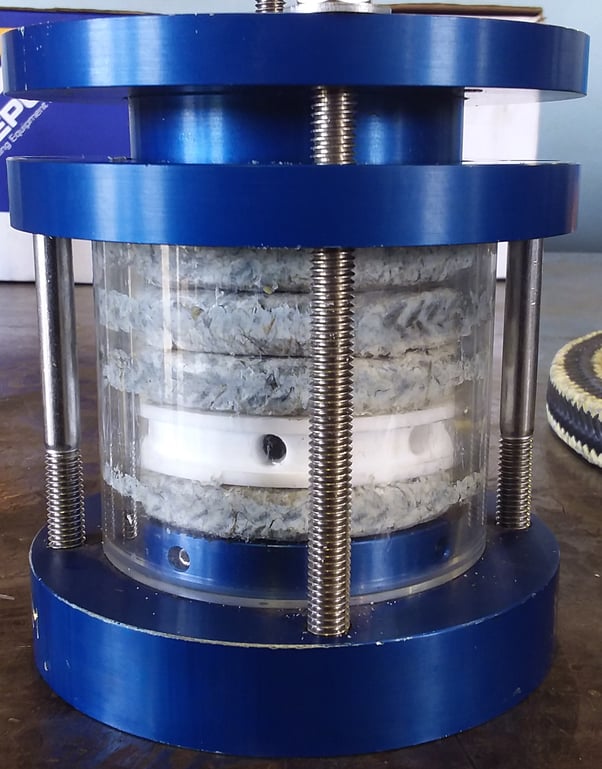
 Every good pump operator understands the importance of a functional and regularly maintained stuffing box. When working properly, the stuffing box separates rotating and non-rotating parts within the pump shaft and prevents slurry leakage. Less commonly understood, however, is how to remove and replace the element that does the actual sealing: the stuffing box packing. Here is a look at how and when to replace packing, as well as why doing it correctly is so important.
Every good pump operator understands the importance of a functional and regularly maintained stuffing box. When working properly, the stuffing box separates rotating and non-rotating parts within the pump shaft and prevents slurry leakage. Less commonly understood, however, is how to remove and replace the element that does the actual sealing: the stuffing box packing. Here is a look at how and when to replace packing, as well as why doing it correctly is so important.
Packing lifespan
Like any other part of a slurry pump, packing material is subject to wear over time and requires regular inspection and replacement. In order to avoid issues with the stuffing box, operators should know the expected lifespan of its packing material. The stuffing box model used, as well as the type of packing material and its lifespan, may depend on one’s pumping application.
While most packing types have similar expected lifespans, the actual lifespan of one’s packing material depends on a few factors. First, operators should know whether or not the packing material is the right one for their application; for this, they can consult the manual that came with their pump. Second, the lifespan depends on whether or not the seal water system is properly designed.
Pump operators should also consider the operating pressure of the pump and sealing water, as well as the slurry’s pH, composition, and temperature. Seal water should be 10 psig (0.7 bar) above the pump’s operating pressure, have a neutral pH, and have an average hardness of 5. Solids should be less than 2500 ppm and 50 microns thick.
If operators maintain the sealing system at those conditions and check the packing on a weekly basis, they can expect a lifespan of six to twelve months.
Replacing packing
The most common sign that packing needs replacement is excessive leakage from the back of the stuffing box. The leakage will likely be cool to the touch and cloudy. In addition, the amount of leakage dripping from the bottom of the box will be noticeably larger than the size of a pencil. You may see spraying or gushing at the site of the leak. If packing is in good condition and properly tightened, exiting water will be at a temperature that is comfortable for handwashing, roughly 115 F (46 C).
Operators may also notice that the gland adjustor is bottomed out; this is another sign of worn packing. Finally, if operators notice that the packing rings have reached their maximum compression state, they should replace them right away.
Although the process for removing and replacing packing is relatively simple, it is essential that operators follow the directions carefully to avoid improper installation.
Removing packing
To remove packing, follow these steps:
- Obtain personal protective equipment (PPE) prior to service, since slurries can be chemically hazardous.
- Identify the type of stuffing box for the packing and lantern ring position details.
- Shut down and lock out the pump. Allow the pump to cool prior to servicing!
- Valve off or drain the slurry from the sump tank and discharge pipe.
- Remove the seal guard and gland adjustor.
- Using a packing ring removal tool or other device, remove the packing and lantern rings.
Installing new packing
To install new packing, follow these steps:
- Apply synthetic assembly lube to the replacement packing.
- Wrap the packing around the shaft sleeve.
- Stagger the ring joints.
- Use a blunt tool to lightly tap each packing ring in place.
- Reinstall the gland adjustor and hand-tighten the gland nuts. Take care not to over-tighten.
- Reinstall the SFT guard.
- Following your plant’s lockout/restart procedure, restart the pump.
- Over a 30-minute span, adjust the gland adjustor until the leakage drip from the back of the stuffing box is roughly the width of a pencil and at handwashing temperature.
Operators should inspect new packing material in the days and weeks following installation. In particular, they should watch for over-tightened packing, which if left to glaze permanently will compromise the sealing performance of the stuffing box. Likewise, they should inspect for loose packing, which will have excessive leakage and can result in failed bearing assemblies.
Stuffing box packing is just one of many parts of a pump that requires regular inspection and maintenance, including replacement. Keeping packing past its prime can have severe consequences, which is why it is essential that operators understand when and why it needs replacement, as well as how to change it properly.
